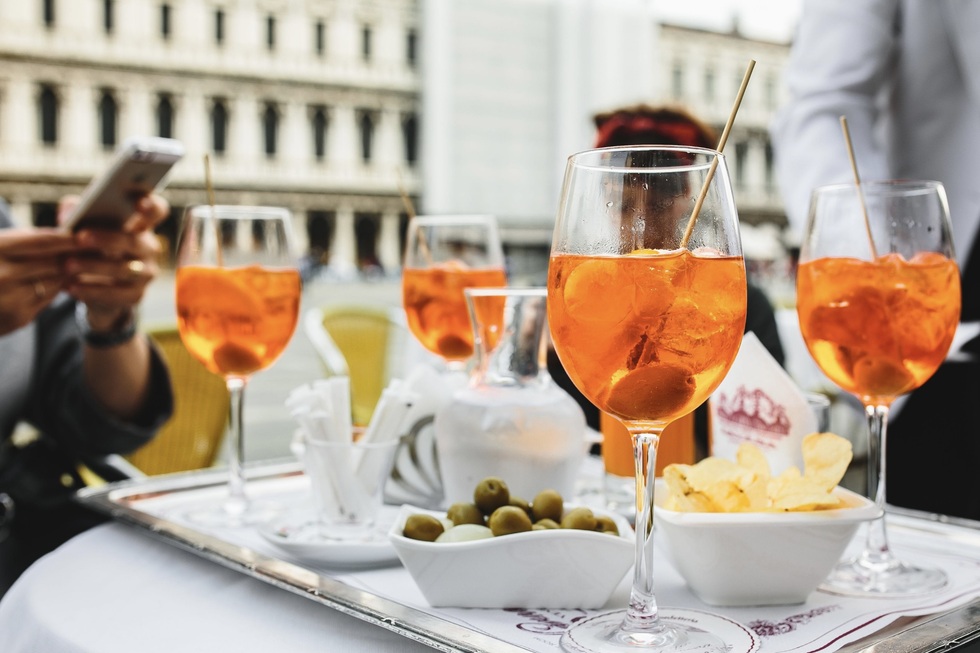When golden hour takes hold in Milan, from Piazza del Duomo all the way to the lively Navigli canal district south of the centro storico, the well-heeled Milanese can be found spilling out of the bars and cafés lining the squares, with bright red or orange drinks in hand.
Those splashes of color are how you know Italy’s before-dinner apéritif (aperitivo) ritual in full swing—and the vibrant drink of choice is the ubiquitous spritz.
The vivid colors, which rhyme with the sunset hour during which they’re commonly enjoyed, come from the use of bitters like Campari or Aperol. Campari, known as “red passion” due to its crimson hue, was invented in Milan in 1860 from a mix of 70 natural ingredients including herbs, fruit, and spices. Its social companion, the bright orange Aperol, was originally concocted near Venice and was later acquired by the Campari company, and it has a similar herbal tone but is a bit sweeter, and some say lighter, in flavor.
What is the recipe for a spritz that's served in Italy? A spritz is typically three parts bubbly (like prosecco or Asti Spumante), two parts bitters such as Aperol or Campari, one part soda, and a touch of added citrus.
Legend has it that the reason this fizzy drink is known as a spritz is because, in the 1800s, Austro-Hungarian soldiers stationed in northern Italy would ask for the strong local wines to be “spritzed” with other ingredients to make them less intense. As the years went on, variations on this sparkling libation became a popular aperitif.
Unlike the happy hours offered in American sports bars, which tend to revolve around beer specials and half-price wings, the spritz aperitif was devised to fulfill both social and digestive functions: It was a way to “open the stomach” before dinner, locals said, using an alcoholic beverage that typically contained herbs and had a slightly medicinal flavor.
You can order a spritz pretty much any time of day in a bar or café in most major Italian cities—particularly in Venice, where the custom is a popular tourist diversion starting in late afternoon—and you’ll even find food trucks and street stalls selling spritzes in plastic cups to passersby. Still, more often than not, if someone sells you a €2 spritz in a plastic cup through a window, it’s probably going to be overly syrupy and full of cheap prosecco.
 (Credit: Shutterstock / RossHelen)
(Credit: Shutterstock / RossHelen)
Few places in Italy serve spritzes with as much sophistication as Milan, a less-touristed, busy city where locals work hard and value their downtime. There, some of the best spritzes can be found at the Aperol Terrace, overlooking Piazza del Duomo (pictured above) or Camparino, an elegant, old-style bar that is also near the famous cathedral but a few steps away in the Galleria.
The historic (yet slightly dated) Bar Basso, near Milan’s Polytechnic University, is another place to enjoy a classic spritz, though this is actually where the Negroni Sbagliato—a variation on the classic cocktail that substitutes sparkling wine for gin, making it a “mistake” Negroni—was said to have been invented on accident.
Of course, there are spritz snobs who believe that Aperol and Campari have become too commercial, so they want their drinks spritzed with more artisanal, harder-to-find bitters.
Tàscaro Bar, in Milan's Isola neighborhood, uses Venice-made Select in place of Aperol or Campari in its signature spritzes. That sharply red bitter is still made the same way as when the company was founded in 1920, featuring notes of rhubarb and red juniper. Select is considered an integral part of the traditional Venetian spritz, which is served throughout the tourist zones of Venice.
In summer, the refreshing Hugo spritz is also wildly popular. It is typically made with St-Germain elderflower liqueur muddled with mint leaves and topped with prosecco and sparkling seltzer water.
So the next time you are in Italy, take part in the famous pre-dinner ritual like the Italians do: with a spritz of your choice, served in bars and cafes along with snacks like focaccia, olives, salumi, and pinzimonio (raw vegetables with an olive-oil dip). Cin cin!






